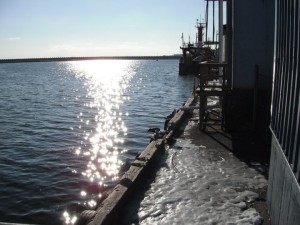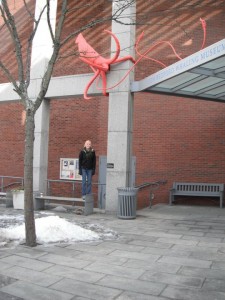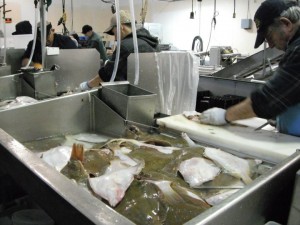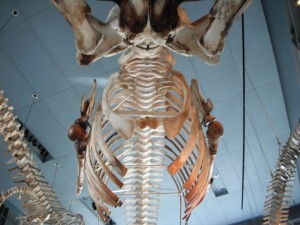I finally took some pictures of interesting things here at SEA, so I’m posting for a second time this week! I am also putting off writing a paper.
One of our courses here at SEA is a maritime studies class, which is intended to prepare us for the voyage experience and what we will witness at our Caribbean port stops. Working our way through European expansion and the colonization of the Eastern Atlantic, we arrived this week at the story of the New England whaling industry. Being that we are currently in New England, this unit was accompanied by a field trip to one of the commercial fishing capitals of the east coast. (We are also reading the classic nautical disaster stories like the mutiny on the Bounty and cannibalism in the Essex, but fortunately those stories didn’t come with field trips.)
We spent the day in New Bedford, Massachusetts, first at a fish processing plant, followed by a commercial scallop vessel, and finally the New Bedford Whaling Museum.
At the commercial processing facility we toured the fish prep area, surrounded by vats of fish parts and a constant trickle salt water. We couldn’t help but notice the distribution of labor in the fish cleaning room. Men worked on one side in individual slots, separating flatfish efficiently from their skins. Behind them on the opposite side of the room, tables of women cleaned fillets more precisely, removing the last bits of vertebrate or scales from the white flesh. Between them a conveyor belt bubbled fillets through a salty brine before moving them to large plastic containers to be put on ice. The majority of the women were young and of color. The men were either Latino or old. A single, middle-aged, white foreman seemed to be running the show; barking orders over the incessant drone of the machinery. The tones of inequality and power differential which was so rampant in New Bedford history seemed not so far off in this modern business.
Perhaps our presence there only exacerbated this dynamic. We were visiting for one pleasant morning what is the daily reality of these peoples’ existence, stepping cautiously in our Sperry’s and snapping pictures of the “exciting’ process.
While at the facility, we were introduced to the Captain of the Kathy Marie, scallop dredge that doubles as a research vessel with the Woods Hole Oceanographic Institute. One of my shipmates had served as an undergraduate researcher on this vessel during the summer of 2010, so the captain invited us to tour the ship. We saw the huge, iron gates that lined the scallop dredge, the metal net which scoops the precious shellfish off the ocean floor. This spurred some rich conversation with my house mate, Bri, who is a Aquaculture and Fisheries Technology major. The intricacies of the commercial fisheries business are as boundless the ocean is big. I’m leaving that poor pun/simile for now because there is more story to tell.
After the tour of the Kathy Marie, we made our way to the New Bedford Whaling Museum. First to catch your eye are the three whale skeletons suspended above the museum lobby. One with a baby, and another actively leaching oil from its bones, the museum was death from the start. This isn’t to say it was not an enjoyable visit, but the juxtaposition of the murder and art of the whaling industry prevailed.
The day was a combination of lecture and free time. At one point, we packed ourselves into the replica of fo’c’sle of a 19th century whaleboat, a dozen wooden bunks in a surprisingly small space. From there, lying in mostly dark, we were serenaded with a classic sea shanty by our professor. I look forward to learning some shanties myself for those midnight watches alone on the sea.
- A view from a fish processing plant in New Bedford.





